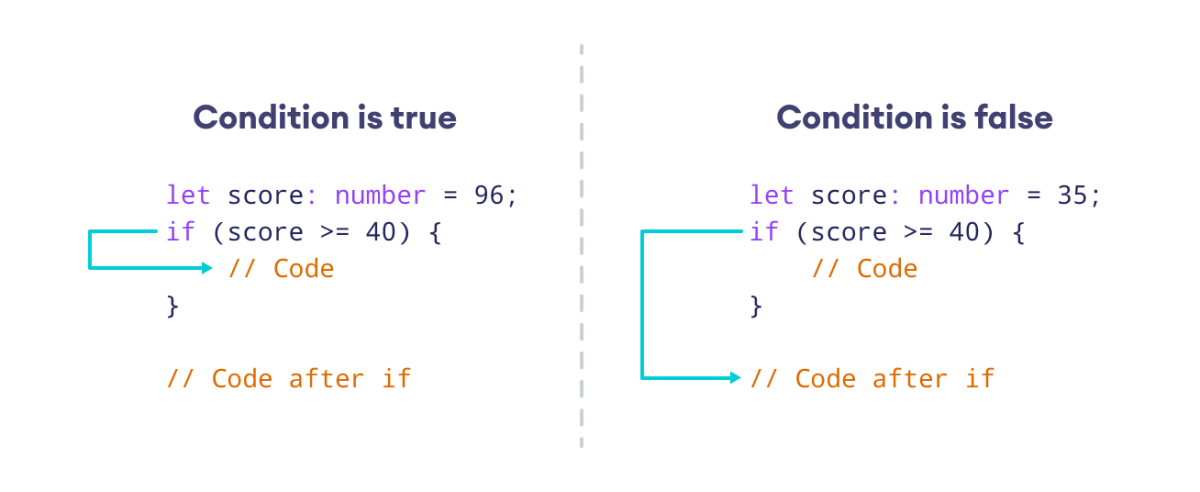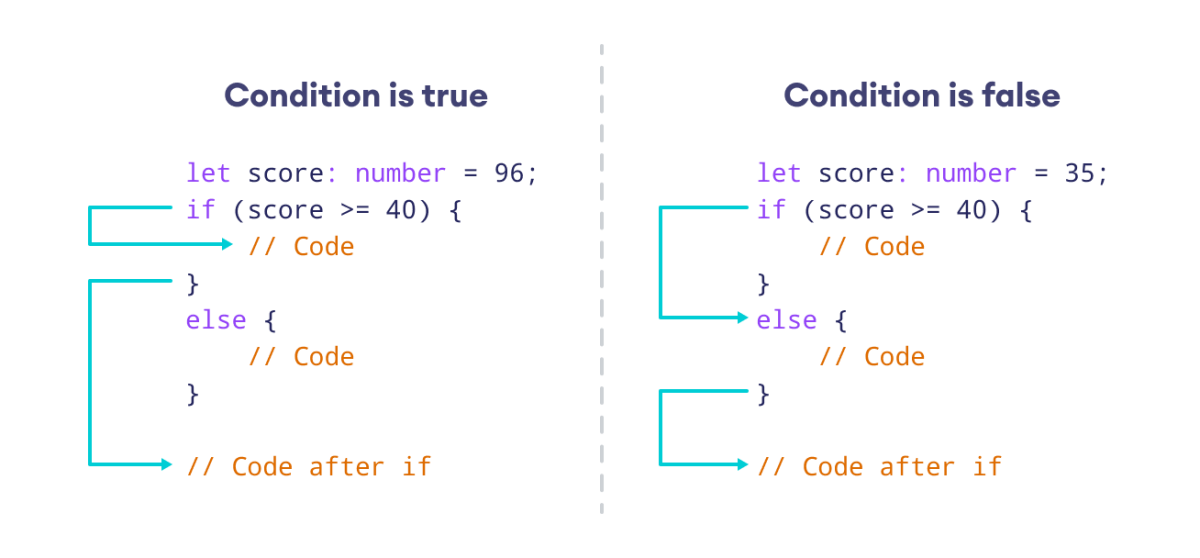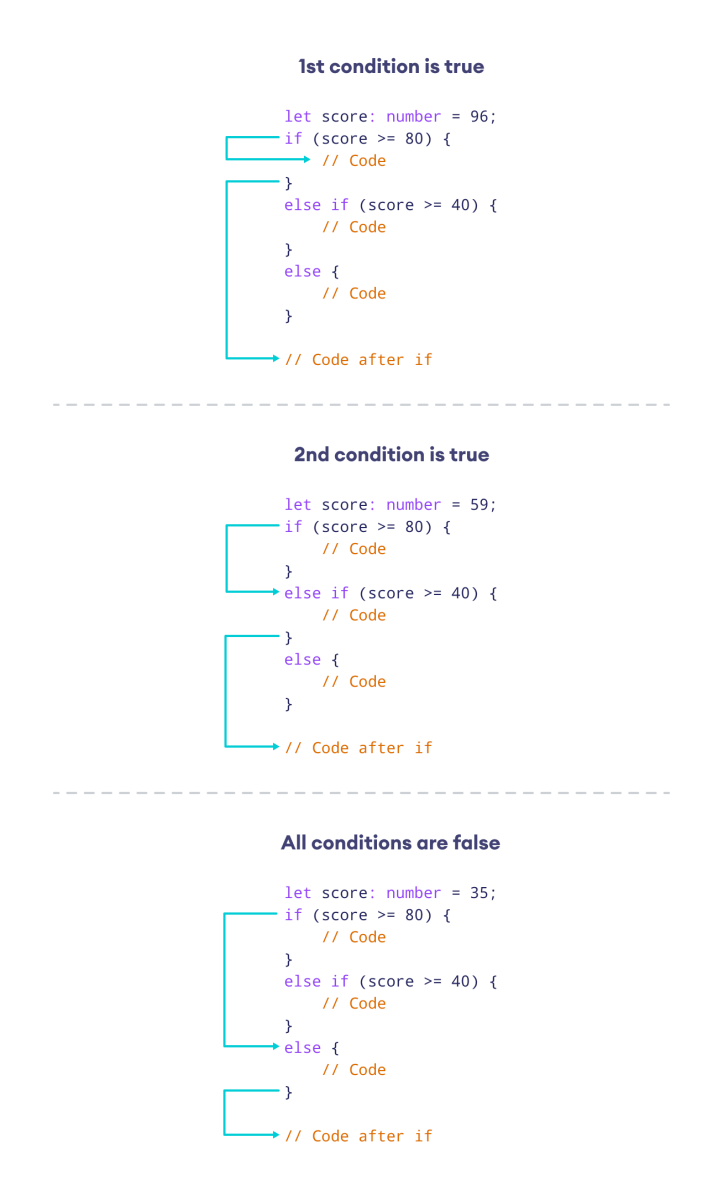注意: 如果您是 TypeScript 新手,请先查看我们的 TypeScript 入门 教程。
TypeScript 中的 if...else 语句用于根据条件执行/跳过一段代码。
这是一个 if...else 语句的简单示例。您可以阅读本教程的其余部分以了解更多信息。
示例
let quantity: number = 35;
// Check if quantity is a positive number
if (quantity > 0) {
console.log("Positive number");
}
// Else, check if quantity is negative
else if (quantity < 0) {
console.log("Negative number");
}
// If both conditions fail, quantity is 0
else {
console.log("Zero");
}
// Output: Positive number在上面的示例中,程序显示
- 如果 quantity 大于 0,则显示
Positive number。 - 如果 quantity 小于 0,则显示
Negative number。 - 如果没有任何条件匹配,则显示
Zero。
TypeScript if 语句
我们使用 if 关键字根据某些特定条件执行代码。
if 语句的语法是
if (condition) {
// Block of code
}if 关键字检查括号 () 中的 condition。如果 condition 的计算结果为
true- 将执行{ }中的代码。false- 将跳过{ }中的代码。
注意: { } 中的代码也称为 if 语句的主体。

示例 1:TypeScript if 语句
// Program to check if the student passed
let score: number = 96;
// Check if score is greater than or equal to 40
if (score >= 40) {
// The body of the if statement
console.log("You passed the examination.");
}
console.log("Program executed!");输出
You passed the examination. Program executed!
在上面的程序中,条件 score >= 40 的计算结果为 true,因为 score 是 96。因此,将执行 if 语句的主体。
如果分数低于 40(例如 35),则不会执行 if 语句的主体。
最后,由于 console.log("Program executed!"); 位于 if 语句主体之外,因此无论 if 语句的结果如何,它都会被执行。
TypeScript else 语句
当前面 if 语句中的条件计算为 false 时,else 关键字将执行一段代码。
注意: else 语句应始终跟在 if 语句之后。换句话说,if 和 else 语句是单个条件结构的一部分。
if...else 语句的语法是
if (condition) {
// Block of code to execute if the condition is true
}
else {
// Block of code to execute if the condition is false
}if...else 语句通过两种方式检查 condition 并执行代码:
- 如果
condition为true,则执行if中的代码。并且,将跳过else中的代码。 - 如果
condition为false,则跳过if中的代码。而是执行else中的代码。

示例 2:TypeScript if…else 语句
// Program to check if the student passed or failed
let score: number = 35;
// Check if score is greater than or equal to 40
if (score >= 40) {
// The body of the if statement
console.log("You passed the examination.");
}
else {
// The body of the else statement
console.log("You failed the examination.");
}
console.log("Program executed!");输出
You failed the examination. Program executed!
由于 score 为 35,因此 if 条件 (score >= 40) 的计算结果为 false。
因此,将跳过 if 中的代码。而将执行 else 中的代码。
当我们要执行单行代码时,可以省略 if…else 语句中的 { }。例如,
let score: number = 35;
if (score >= 40)
console.log("You passed the examination.");
else
console.log("You failed the examination.");
// Output: You failed the examination.TypeScript else if 语句
如果初始 if 语句为 false,则使用 else if 关键字来检查其他条件。
else if 语句的语法是
// Check for first condition
if (condition1) {
// if body
}
// Check for second condition
else if (condition2){
// else if body
}
// If no condition matches
else {
// else body
}这里
- 首先,检查
if语句中的条件。如果条件计算为true,则执行if的主体,并跳过其余部分。 - 否则,检查
else if语句中的条件。如果为true,则执行其主体并跳过其余部分。 - 最后,如果没有条件匹配,则执行
else中的代码块。

示例 3:TypeScript if...else if 语句
let score: number = 59;
// Check if score is 80 or above
if (score >= 80) {
console.log("Excellent!");
}
// Else, check if score 40 or above
else if (score >= 40) {
console.log("Average");
}
// If both conditions fail, you fail the exam
else {
console.log("Failure!");
}输出
Average
在这里,if 条件为 false,因为 score 是 59。但是,else if 条件满足,因此程序打印 Average。
我们可以根据需要多次使用 else if 关键字。例如,
let score: number = 85;
// Condition for passing with second division
if (score >= 40 && score < 60) {
console.log("Second division");
}
// Condition for passing with first division
else if (score >= 60 && score < 80) {
console.log("First division");
}
// Condition for passing with distinction
else if (score >= 80 && score <= 100) {
console.log("Distinction");
}
// Condition for failing the exam
else if (score > 0 && score < 40) {
console.log("You failed the examination.");
}
// If all conditions fail, the score is invalid
else {
console.log("Invalid score!");
}
// Output: Distinction在上面的示例中,我们使用了三个 else if 语句。
第二个 else if 语句被执行,因为它的条件得到了满足,而 if 和第一个 else if 语句的条件未得到满足。
嵌套 if...else 语句
当我们使用嵌套在另一个 if...else 语句中的 if...else 语句时,我们就创建了一个嵌套 if...else 语句。例如,
let score: number = 60;
// Outer if...else statement
// Student passed if score 40 or above
// Otherwise, student failed
if (score >= 40) {
// Inner if...else statement
// Distinction if score is 80 or above
if (score >= 80) {
console.log("Distinction");
}
else {
console.log("Passed");
}
}
else {
console.log("Failed");
}
// Output: Passed外部 if...else 语句
在上面的示例中,外部 if 条件使用条件 score >= 40 检查学生是及格还是不及格。如果计算结果为 false,则外部 else 语句将打印 "Failed"。
另一方面,如果 score >= 40 的计算结果为 true,程序将进入内部 if...else 语句。
内部 if...else 语句
内部 if 条件使用条件 score >= 80 检查学生是否以优异成绩及格。
如果 score >= 80 的计算结果为 true,则内部 if 语句将打印 "Distinction"。
否则,内部 else 语句将打印 "Passed"。
注意: 为了保持代码的可读性并简化调试,请避免将多个 if...else 语句相互嵌套。
更多关于 TypeScript if...else 语句
如果我们的操作非常简单,我们可以使用三元运算符 ?: 代替 if...else 语句。例如,
let score: number = 40;
let result;
if (score >= 40)
result = "pass"
else
result = "fail"
console.log(result);
// Output: pass可以写成
let score: number = 40;
let result = (score >= 40) ? "pass" : "fail";
console.log(result);
// Output: pass当我们需要处理大量条件时,我们可以用 switch 语句替换我们的 if...else 语句。
例如,
let score: string = "C";
// Using if else for many conditions
// First condition
if (score === "A") {
console.log("Excellent!");
}
// Second condition
else if (score === "B") {
console.log("Good!");
}
// Third condition
else if (score === "C") {
console.log("Average");
}
// Fourth condition
else if (score === "D") {
console.log("Bad");
}
// Otherwise, execute else block
else {
console.log("Fail");
}
// Output: Average在上面的示例中,我们使用了 if...else 来评估五个条件,包括 else 块。
现在,让我们使用 switch 语句来实现相同的目的。
let score: string = "C";
// using switch...case
switch (score) {
// First condition
case "A":
console.log("Excellent!");
break;
// Second condition
case "B":
console.log("Good!");
break;
// Third condition
case "C":
console.log("Average");
break;
// Fourth condition
case "D":
console.log("Bad");
break;
default:
console.log("Fail");
}
// Output: Average如您所见,switch 语句使我们的代码更具可读性和可维护性。
此外,与冗长的 if...else 语句链相比,switch 的运行速度更快。
我们可以在 if 语句中使用逻辑运算符,如 && 和 || 来添加多个条件。例如,
let age: number = 35;
let salary: number = 6000;
// Combine two conditions using the "and" operator &&
if (age >= 30 && salary >= 5000) {
console.log("Eligible for premium membership.");
}
else {
console.log("Not eligible for premium membership.");
}
// Output: Eligible for premium membership.在这里,我们在 if 语句中使用了逻辑运算符 && 来添加两个条件。这两个条件是:
age >= 30salary >= 5000
由于 && 运算符,必须使两个条件都为 true 才能执行 if 块。
是的,您可以在 if...else 语句中使用用户输入。只需确保已将输入转换为合适的类型即可。例如,
// Get user input from prompt(), which returns either string or null data
const userInput: string | null = prompt("Enter your exam score:");
// Check if user input is null
if (userInput === null) {
console.log("Null input given!");
}
// Else, convert input to integer and check condition
else {
let score: number = parseInt(userInput);
// Check if the user passed or failed
if (score >= 40)
console.log("pass");
else
console.log("fail");
}在这里,我们使用了 prompt() 函数来获取用户输入。如果用户提供输入数据,prompt() 将其作为字符串返回。
但是,如果用户按下 Cancel 按钮,prompt() 将返回 null。因此,我们需要检查此条件。
一旦我们确定输入不是 null,我们就可以使用 parseInt() 函数将输入转换为整数,然后检查用户是及格还是不及格。
另请阅读